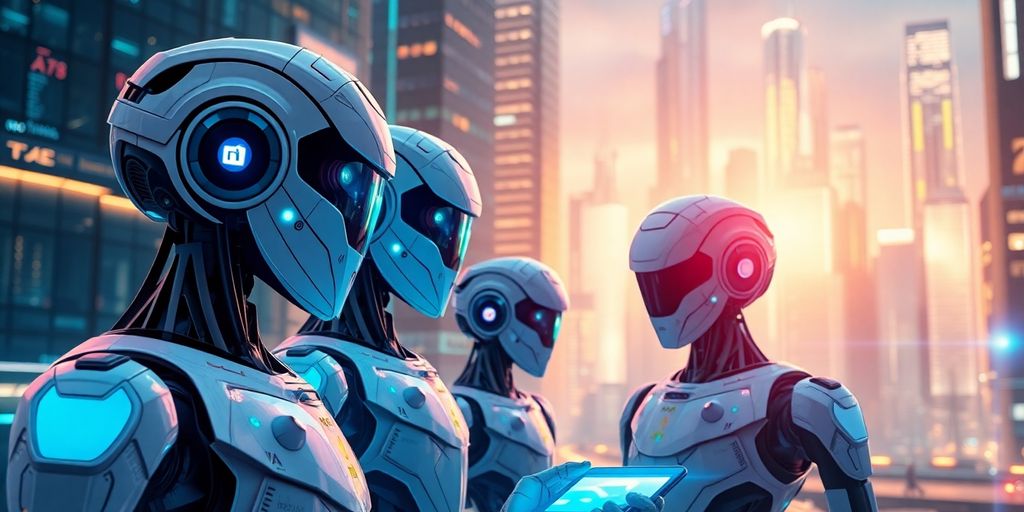Ever wonder what autonomous AI agents are and how they’re changing the tech world? These aren’t your typical AI systems. They’re designed to think and act on their own, making decisions based on the tasks they’re given and the environment they find themselves in. Unlike traditional AI, they don’t need someone to tell them what to do at every step. Instead, they can plan, adapt, and even change their approach to get things done. This makes them super useful in areas like healthcare, automotive, and cybersecurity. As they continue to evolve, these agents are set to revolutionize industries by taking on complex tasks that would otherwise require a human touch.
Key Takeaways
- Autonomous AI agents operate independently, planning and executing tasks without constant human input.
- These agents are already being used in industries like healthcare, automotive, and cybersecurity.
- They differ from traditional AI by their ability to adapt and change strategies based on their environment.
- Challenges include technical limitations, ethical concerns, and regulatory issues.
- The future holds even more advanced AI agents that could transform various sectors.
Understanding Autonomous AI Agents
Defining Autonomous AI Agents
Autonomous AI agents are sophisticated systems that operate without needing constant human oversight. These agents are designed to learn from their surroundings, adapt to new situations, and make decisions to achieve specific goals. Unlike traditional AI systems, which rely heavily on predefined algorithms and instructions, autonomous agents can independently choose their pathways to complete tasks. They leverage tools and memory to adapt, solve problems, and sometimes even surprise their human counterparts with creative solutions.
Key Features of Autonomous AI Agents
Autonomous AI agents are characterized by several key features:
- Independence: They can operate without direct human intervention after the initial setup.
- Adaptability: These agents adjust their strategies based on environmental changes and new data inputs.
- Problem-solving Abilities: They can identify issues and devise solutions without external guidance.
The beauty of autonomous AI agents lies in their ability to continuously learn and evolve, making them invaluable in dynamic environments.
How Autonomous AI Agents Differ from Traditional AI
The main distinction between autonomous AI agents and traditional AI lies in their operational approach. Traditional AI systems work within the confines of specific programming and rules. In contrast, autonomous agents are designed to learn from their experiences and refine their actions over time. This capability allows them to perform complex tasks like planning, decision-making, and even executing actions that were not explicitly programmed. By utilizing a combination of memory and external tools, these agents can operate more like independent entities, capable of achieving tasks in a more human-like manner.
The Evolution of Autonomous AI Agents
Early Developments and Milestones
Autonomous AI agents didn’t just pop up overnight. They’ve been years in the making, with a few key milestones marking their journey. Back in 2022, the world saw a noticeable shift with the rise of generative AI tools like ChatGPT, MidJourney, and Jasper. These tools, while not entirely autonomous, laid the groundwork for what was to come. They demonstrated that AI could handle tasks that were once considered too complex for machines, albeit at a basic level.
- 2022: Introduction of generative AI tools capable of handling low-to-medium complexity tasks.
- 2023: Rapid integration of these tools into various industries, showcasing their potential.
- 2024: Emergence of autonomous agents, building on the capabilities of generative AI.
Advancements Leading to Autonomy
The journey from generative AI to fully autonomous agents involved several key advancements. While generative AI was impressive, autonomous agents brought things to a new level. These agents can complete multiple tasks in a sequence, using both internal tools and external data sources. Unlike earlier AI, they don’t need constant human supervision. They can tap into databases or websites, expanding their knowledge and capabilities beyond what generative AI could achieve.
- Access to external data sources like databases and websites.
- Ability to perform tasks sequentially without human intervention.
- Enhanced learning from past experiences, improving over time.
The Role of Generative AI in Evolution
Generative AI played a pivotal role in paving the way for autonomous agents. It showcased the potential of AI to not just perform tasks but to learn and adapt. By linking thoughts and actions, generative AI set the stage for more advanced systems. Autonomous agents took these principles and ran with them, combining memory and tools to achieve goals independently. They represent a significant leap forward, capable of handling complex tasks that require a level of decision-making and adaptability not seen before.
Autonomous AI agents are reshaping the technological landscape, transforming how tasks are approached and completed, with minimal human input. They symbolize a future where AI systems not only assist but autonomously drive innovation and efficiency.
For more insights into the development of AI agents, check out this comprehensive white paper, exploring how these autonomous systems sense, learn, and act within their environments.
Applications of Autonomous AI Agents
Autonomous AI in Healthcare
Autonomous AI agents are making waves in healthcare. These digital helpers can speed up diagnostics, analyzing medical images like X-rays and MRIs faster and sometimes more accurately than humans. They also assist in crafting personalized treatment plans, which can lead to better patient outcomes. Plus, they help streamline administrative processes, making hospitals run smoother and cutting down on costs.
Use in Automotive Industry
In the automotive world, autonomous AI is the backbone of self-driving cars. Take Tesla’s Autopilot, for example. It uses cameras and sensors to navigate roads, identify obstacles, and make real-time driving decisions. This tech isn’t just about driving itself; it’s about making roads safer and reducing human error.
Impact on Cybersecurity
Cybersecurity is another area where autonomous AI is proving its worth. These agents can detect and respond to threats more quickly than traditional methods. They analyze patterns and flag unusual activities, helping to prevent data breaches before they happen. This proactive approach is essential in a world where cyber threats are constantly evolving.
Autonomous AI agents are not just tools; they’re partners in progress, reshaping industries with their ability to learn and adapt independently.
Challenges and Limitations of Autonomous AI Agents

Technical Challenges
Autonomous AI agents are often hailed for their potential, but they come with their own set of headaches. AI agents need a lot of data to work well, and if this data is flawed or biased, the results can be way off. They also struggle with tasks that require understanding beyond their programming, like interpreting subtle human emotions or complex social cues. Plus, many are built for specific tasks and can’t pivot easily to others. This narrow focus can be a real limitation when flexibility is needed.
Ethical Considerations
The deployment of these agents raises some serious ethical questions. They can unintentionally breach ethical guidelines, especially if they’re not monitored closely. There’s also the issue of privacy—these agents often handle sensitive information, and if not properly secured, they could become a target for breaches. It’s crucial to address these concerns to prevent misuse and ensure that the agents act in a manner that’s consistent with societal values.
Regulatory and Compliance Issues
Regulatory frameworks for AI are still catching up, and this lag can create compliance headaches. Companies using autonomous agents must navigate a patchwork of regulations that might not fully address the complexities of AI. This can lead to uncertainty and potential legal challenges. Ensuring that these agents adhere to existing laws while anticipating future regulations is a balancing act that requires ongoing attention.
As we race towards an AI-driven future, it’s essential to weigh the benefits against the possible pitfalls. The rapid development and deployment of autonomous agents in artificial intelligence presents significant ethical, security, and governance challenges that require careful consideration. Learn more about these challenges.
In summary, while autonomous AI agents offer exciting possibilities, they also bring along a host of challenges that need to be carefully managed. From technical hurdles and ethical dilemmas to regulatory complexities, the path forward requires thoughtful planning and robust frameworks to harness their full potential responsibly.
The Future of Autonomous AI Agents
Predicted Technological Advancements
Autonomous AI agents are expected to grow even smarter and more capable in the coming years. These agents will likely develop advanced contextual awareness, using technologies like NLP, computer vision, and deep learning to interact more naturally with humans. Imagine an AI that not only understands your words but also grasps the nuances of your tone and body language. That’s where we’re headed. Multi-agent systems will become more common, allowing AI agents to work together to solve complex problems. This collaboration could lead to breakthroughs in fields like healthcare, where AI agents could analyze patient data collectively to improve diagnosis and treatment.
Potential Industry Transformations
The impact of autonomous AI agents on industries will be profound. In healthcare, these agents could revolutionize patient care by providing real-time monitoring and personalized treatment plans. In the automotive industry, autonomous AI will drive the development of self-driving cars that communicate with each other to reduce traffic and accidents. Even in cybersecurity, AI agents will play a crucial role in identifying threats and responding to them faster than any human could. As these agents become more integrated into various sectors, they will transform the way businesses operate, making them more efficient and responsive.
The Role of Multi-Agent Systems
Multi-agent systems are set to redefine how tasks are executed across networks. These systems allow multiple AI agents to collaborate, sharing information and responsibilities to achieve common goals. This approach not only enhances efficiency but also ensures that tasks are completed faster and more accurately. In the future, multi-agent systems could be used in everything from managing smart cities to optimizing supply chains. The ability of these agents to work together seamlessly will be a game-changer, allowing for more sophisticated and dynamic solutions to complex problems.
As we look to the future, it’s clear that autonomous AI agents will not only augment human capabilities but also open up new possibilities for innovation and growth. Businesses that embrace this technology will likely lead the way in their respective industries, setting new standards for what’s possible.
Integrating Autonomous AI Agents into Business
Preparing Your Workforce
When you’re getting ready to bring autonomous AI agents into your business, the first step is to prepare your team. Education is key. Employees need to understand what these agents can do and how they’ll work alongside them. Start with training programs that focus on the capabilities of AI agents and how they can help rather than replace human workers. Address any worries about job security by emphasizing that these agents are there to augment human roles, not take them over.
Establishing Ethical Guidelines
Implementing autonomous AI agents in businesses necessitates a strategic approach for seamless integration with existing systems. This involves careful planning and consideration of the technology’s capabilities to enhance operational efficiency and decision-making. Setting up ethical guidelines is crucial to ensure these technologies are used responsibly. Develop a framework that covers transparency, accountability, and compliance with regulations. Regularly review and update these guidelines to stay aligned with legal standards and societal expectations.
Maximizing Efficiency and Productivity
To make the most of autonomous AI agents, businesses should focus on areas where these tools can really shine. Look at your current processes and pinpoint where AI can streamline operations. Here’s a quick list to consider:
- Automate Routine Tasks: Use AI to handle repetitive tasks, freeing up human resources for more strategic work.
- Data Analysis: Leverage AI for real-time data analysis to identify trends and make informed decisions quickly.
- Customer Interaction: Deploy AI chatbots to manage customer queries efficiently, enhancing the customer experience.
By integrating AI strategically, businesses can transform operations, making them more efficient and productive. The key is to ensure that these systems are well-aligned with business goals and are continuously monitored to adapt to changing needs.
Autonomous AI Agents and Society

Impact on Employment
Autonomous AI agents are changing the job landscape in big ways. While some worry about job losses, others see new opportunities. AI can handle repetitive tasks, freeing up humans for more creative roles. But it’s not that simple. As AI takes over certain jobs, people will need to learn new skills to stay relevant. Companies might need to invest in retraining programs to help their workers shift to new roles.
Here’s a quick look at how AI might affect different job sectors:
| Job Sector | Impact of AI |
|---|---|
| Manufacturing | Automation of routine tasks |
| Healthcare | Assistance in diagnosis and care |
| Retail | Improved inventory management |
Cultural and Social Implications
AI isn’t just about jobs; it’s about how we live our lives. With AI agents becoming part of our daily routines, our interactions with technology are more personal than ever. This shift raises questions about privacy and the nature of human relationships. Some people worry that relying too much on AI could make us less social, while others think it might just change the way we connect.
- Privacy concerns with AI collecting data
- Changes in how we communicate
- New forms of digital companionship
Balancing Human and AI Collaboration
For AI agents to truly benefit society, we need to find a balance between human and machine work. This means creating environments where AI and humans can work together effectively. It’s not about replacing people but enhancing what we can achieve together. To do this, we need clear guidelines on how AI should be used and make sure everyone understands the potential and limits of these technologies.
As AI agents become more common, the focus should be on collaboration, not competition. By working together, humans and AI can tackle challenges that neither could solve alone.
In the end, AI agents are set to revolutionize various industries and address societal challenges, emphasizing the importance of collaboration to harness their potential while minimizing associated risks.
Conclusion
So, there you have it. Autonomous AI agents are not just some sci-fi fantasy anymore. They’re here, and they’re changing the game in ways we couldn’t have imagined a few years back. From helping out in industries like healthcare and manufacturing to making our daily lives a bit easier, these agents are proving to be more than just a tech trend. Sure, there are challenges and ethical questions to tackle, but the potential benefits are huge. As they keep getting smarter and more capable, who knows what they’ll be able to do next? It’s an exciting time for tech, and autonomous AI agents are right at the heart of it.
Frequently Asked Questions
What are autonomous AI agents?
Autonomous AI agents are smart systems that can make decisions and solve problems on their own. Unlike regular AI, they don’t need detailed instructions for every action. They can plan, adapt, and use tools to reach goals set by humans.
How do autonomous AI agents differ from traditional AI?
Traditional AI follows set rules and needs specific instructions. Autonomous AI agents, however, can learn from their surroundings and make decisions without constant human guidance.
Where are autonomous AI agents used today?
These agents are used in many places like healthcare, cars, and cybersecurity. They help automate tasks and solve complex problems, making work easier and faster.
What challenges do autonomous AI agents face?
Autonomous AI agents face challenges like technical difficulties, ethical issues, and the need to follow rules and laws. They must be designed carefully to work well and safely.
How might autonomous AI agents change the future?
In the future, these agents could transform industries by taking on more tasks and working alongside humans. They could make processes more efficient and open up new possibilities in technology and business.
How can businesses prepare for autonomous AI agents?
Businesses can prepare by training their workers, setting clear ethical guidelines, and finding ways to use these agents to boost productivity and efficiency.




